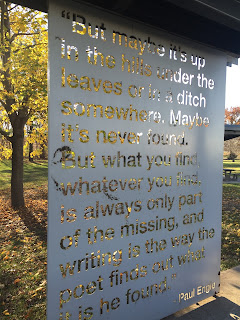We travelled the entire breadth of beautiful Iowa today, from the Missouri River and Council Bluffs/Omaha in the west to the Mississippi River and Davenport/Bettendorf/Rock Island/Moline (the Quad Cities) in the east - 296 miles.
We began this morning crossing this bridge in Council Bluffs to get to I-80. The sculpture, dubbed "Spiky Towers", but really called "Odessey", by Albert Paley, (August 2010) at the 4 corners of the bridge was brutal. Meant to represent the transformation of the land through machinery and agriculture, the sculpture has generated a great deal of criticism.
The entire way I-80 would go up a hill, down the hill, cross a small valley and then go up a hill again. I guess you would call the interstate "rolling". Frederick was intrigued by the terraced fields, especially in western Iowa.
Here is the long view of the terraces in the field. The picture above shows a close-up.
Lunch stop at a rest area just east of Des Moines. The temperature was 80 degrees, there was beautiful fall color and a most pleasant companion.
Trucks dominate I-80 and...
we noticed one of Peter's favorites. How many have you counted since you were 6 years old?
This is also corn harvesting time in Iowa and...
these signs were presented every twenty miles, or so.
Not clear wether this refers to deer deaths or people; probably deer.
One of the best parts of the day was stopping at the eastbound rest area in Tiffin, just outside Iowa City. It is devoted to Iowa writers and the Writer's Workshop sponsored by the University of Iowa.
Wooden block letters identify...
the appropriate restroom.
Outside, picnic shelters have steel "pages" to act as screens, each has a quotation from an Iowa writer, either born here or connected with the Writers' Workshop, laser-cut into the "page." I couldn't decide which one to show, so here are most of them.
"I loved the house the way you would any new house, because it is populated by your future, the family of children who will fill it with noise or chaos and satisfying busy pleasures." Jane Smiley
"Well, either you're closing your eyes to a situation you do not wish to acknowledge or you are not aware of the caliber of disaster indicated by the presence of a pool table in your community. Ya got trouble, my friend, right here, I say, trouble right here in River City." Meredith Wilson
"To each other, we were as normal and nice as the smell of bread. We were just a family. In family even exaggerations make perfect sense." John Irving
"But maybe it's up in the hills under the leaves or in a ditch somewhere. Maybe it's never found. But what you find, whatever you find, is always only part of the missing, and writing is the way the poet finds out what it is he found." Paul Engle
"Death is one moment, and life is so many of them." Tennessee Williams
"I am eternally grateful... for my knack of finding in great books, some of them very funny books, reason enough to feel honored to be alive, no matter what else might be going on." Kurt Vonnegut
"There is a lost soldier in every ceramic bowl. The face on the dinner plate breaks when the dish does and lies for centuries unassembled in the soil. These things that have the right substance to begin with, put into the fire at temperatures that melt glass, keep their fingerprints forever, it is said, like inky sponges that walk away in the deep water." Marvin Bell
"There's no money in poetry because most of my neighbors, and most of your, don't have any use for it. If, at a neighborhood yard sale, you happened to find the original handwritten manuscript of T.S. Eliot's "The Waste Land," you could take it to every quick shop in your city and you wouldn't find a single person who would trade you ten gallons of gas for it." Ted Kooser
It also turns out that in 1856, some 1300 Mormon converts from Europe, reached the railroad "end-of-the-track" in this location near Iowa City. From here 5 groups of Mormons used carts to carry their belongings to Salt Lake City. The first three Handcart expeditions reached Salt Lake City safely before cold weather set in. The fourth and fifth Handcart groups suffered untold hardships and death.
And, very near here, in West Branch, is the Herbert Hoover National Historic Site which honors the birthplace of Herbert Hoover; orphaned at 9; president of the United States at 54.







































































